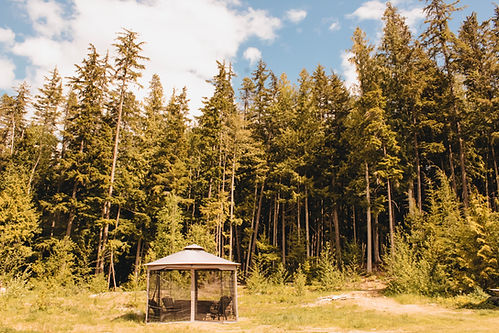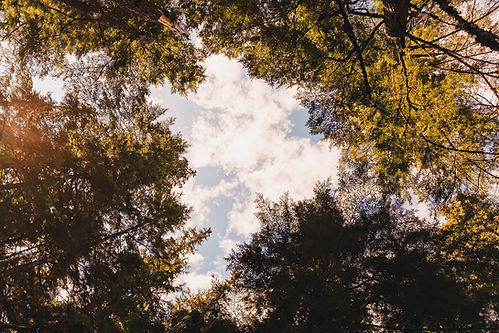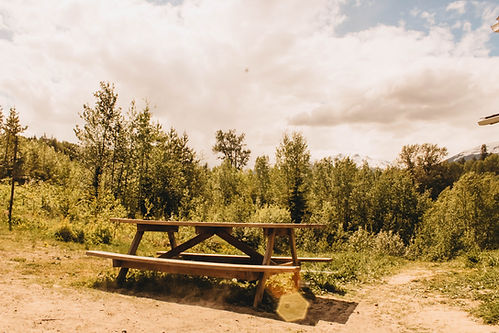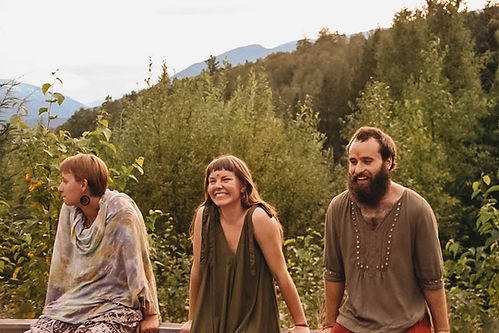
The Ashram
A Life's Journey
By Bhairav Thomas English
The Vision in Darkness
In the autumn of 2001, during a five-day retreat into complete darkness, I received what I now recognize as the seminal vision of my life’s work. Immersed in uninterrupted silence and absence of light—deprived of all external stimuli—I experienced an inner awakening of intuition. In that profound stillness, something essential was unlocked within me. It was there, that the image of an ashram first arose with unmistakable clarity. It did not appear as a fleeting idea or aspiration, but rather as a directive, as though a latent blueprint within me had been activated.
That experience became a defining threshold. Emerging from the darkness, I knew that the next phase of my life would revolve around manifesting this vision—a place rooted in spiritual retreat, contemplation, and communion with the world. The idea of acquiring land and creating a sanctuary for others to rest, reflect, and transform began to guide my every decision.
Although the vision had taken root in 2001, it was not until 2005 that I made my way back to Canada to begin the physical search for the land. I had been away for nearly seven years, and returning meant starting over: acquiring a vehicle, reestablishing basic infrastructure, organizing health care, and then, finally, embarking on the long road west.
At the time, online listings for remote properties were sparse, so I began the search the old-fashioned way—by physically traversing the country. I drove across vast expanses, beginning in Newfoundland, through the dense woods and rugged landscapes of Northern Ontario. By the time I reached Winnipeg, a friend suggested I explore property listings online—an idea that proved pivotal. It was through that digital window that I discovered a remote parcel of land in British Columbia.
I contacted the owner and set out toward the northwest of the province. This was around July. The journey led me to the isolated Grease Trail Road, where I encountered my first major obstacle: the access bridge had been washed out. Undeterred, I began to hike the trail on foot, encountering numerous bears along the way—a powerful reminder of the wildness I was entering. A local lent me a bicycle, and I used it to navigate deeper down the trail to the property itself.
What I found was raw, elemental land—wild ferns towered overhead, a single rustic cabin stood as the only human imprint. The terrain was rugged, the forest thick, the atmosphere primal. I wandered the property, ascending to a ridge, discovering a waterfall, and hiking further to the Nass River. At first, I was unsure. The land was beautiful but demanded commitment. I resolved to keep looking.
Next, I journeyed to the Gulf Islands, spending time on Cortez and exploring possibilities further south. Yet, the cost of property there proved prohibitive, and something in me kept returning to the northern landscape. By September of that year, the decision was made. I would return to the land near Nass Camp, just north of Terrace and not far from the Alaskan border. That would be the future home of the ashram—both a personal refuge and a spiritual center for others.
Thus concludes Part One of the story: the vision’s inception, the long pilgrimage across country and inner landscape, and the eventual choosing of the land where the dream would take root.



Foundations in the Wilderness
On September 8th, 2005, I purchased the land that would become the ashram—a simple transaction that belied the depth of its significance. The following day, I returned to the property, a teepee packed in my trunk along with my camping gear, prepared to live in the wild for several weeks while slowly bringing the old cabin into order. Upon arrival, I laid makeshift planks across the washed-out bridge and crossed over. I expected to be in the teepee for some time, but within a single day I had cleaned and repaired the cabin enough to make it habitable. I spent only one night under canvas before beginning my life in the shelter that would become the heart of the ashram.
The months that followed—September through early December—were luminous with purpose and quiet fulfillment. The ashram, entirely off-grid and tucked far from roads or urban life, gave me a level of silence and communion with the natural world that I had only previously glimpsed in retreat. There were long rains that autumn, but even they seemed to bless the land. I worked hard to make the space livable: scrubbing, repairing, clearing, grounding myself in the rhythm of nature and labor.
I left in early December for a short journey to Thailand and returned in August of the following year. It was then that my father first joined me at the land. Together we began more serious renovations—laying a proper floor, replacing the roof, and dismantling the remnants of decay that had accumulated over the years. That winter, I entered my first full three-month retreat on the land, along with my partner at the time. Isolated by snow, we made occasional trips into town—perhaps once every three or four weeks—but otherwise spent our days in silence, meditation, and simplicity: tending the fire, eating modest meals, and living in tune with the rhythms of solitude and devotion.
In the early years, the ashram was less a center for others and more a hermitage—a place where I lived in sādhanā, with only occasional visitors. Over the next several years, my father and I—alongside close friends and family, especially our dear friend Carl Reynolds—poured ourselves into the land. We restored the log cabin, built a smaller guest cabin, and then a modest yoga hall. One by one, new structures appeared: three additional cabins, and eventually a dormitory.
In 2009, as the yoga hall neared completion, we welcomed our first volunteers. By 2011, we held our first official retreats. That same year, volunteer participation increased significantly, and from that energy we birthed the Karma Yoga Program, also called the Seva Program—a daily rhythm of selfless service, yoga, meditation, and simple communal meals. Inspired by traditional ashram life in India, this program attracted many seekers, and the ashram began to awaken as a community, not just a personal sanctuary.

A profound turning point arrived in 2014, when I met Artemis Emily Doyle. Artemis entered the ashram as a practitioner, but quickly became a transformative force. Her insight, dedication, and deep spiritual presence helped lift the ashram to a new level—both materially and energetically. Together, we undertook the task of refining the space: cleaning, beautifying, and preparing it to welcome a wider public. With Artemis’s presence, we were able to hold space both for sincere practitioners and for visitors from more diverse walks of life, including those able to contribute financially. Yet always, the heart of the ashram remained grounded in Seva and spiritual practice.
By this time, the dining hall was already underway. Over the next few years, we saw the completion of one of the ashram’s most beloved structures: a 1,600-square-foot straw bale building, raised by volunteers with their own hands—a true work of devotion and love.
In the summer of 2018, Artemis and I celebrated our union in marriage on the land that had long nourished our shared spiritual path. Surrounded by friends, family, students, and members of our extended community, we gathered in ceremony—held not just as a personal celebration, but as a sacred rite honoring the life we were weaving together. The land, already hallowed by years of practice, welcomed this new blessing with grace.
This time also marked the consecration of a sacred temple space nestled in the eastern reaches of the ashram, a grove we came to call the Forest Temple. Hidden among the tall trees, this space emerged as a sanctuary for deep inner work. It became a refuge in the seasons that followed—for us, for our community, and for the quiet seekers drawn to its stillness. That summer was a threshold moment: both a celebration of love and a further deepening of the spiritual architecture of the ashram.
The ashram had become a living mandala: a space where spiritual life unfolded not only through meditation and yoga, but also through the shared work of community. Season after season, practitioners, friends, family, and volunteers returned. Some came for brief visits; others stayed for years. All came to touch something sacred—something that had quietly grown from a vision in darkness into a lived reality of beauty, discipline, and devotion.



The Turning of the Tide
By 2019, the ashram had reached what might be called its zenith. That year, we hosted upwards of 45 to 50 individuals at the height of the summer season. The land pulsed with vitality—daily rhythms of yoga, karma yoga, meditation, shared meals, and quiet devotion. There was a sense that the dream we had cultivated for nearly two decades had finally taken full form. The vision that first emerged in darkness years earlier had become a living reality, and we stood on the threshold of further expansion.
Then, in early 2020, the world changed.
With the arrival of the COVID-19 pandemic, everything we had built came into question. The ashram, so deeply dependent on in-person presence, international travel, and community participation, suddenly became unsustainable. In that year, the ashram welcomed only a small handful of people. We held on, adapting as best we could.
In 2021, the doors opened slightly more, but only a few guests came. By 2022, we hoped for a full reopening. There was so much anticipation—many of us felt it would be the great return. But the world had changed. That summer, which was meant to be our recovery and renewal, was instead a season of reckoning. Attendance remained low, and we found ourselves struggling to make ends meet.
In response, we launched a large fundraising campaign. Thanks to the love and generosity of our extended community, we reached our goal and were able to clear our outstanding debts. It was a moment of profound relief and gratitude. And yet, even with that support, we had only just returned to zero. The funds allowed us to catch our breath—but not to move forward. Beneath the surface, a more difficult truth was becoming clear: the life we had envisioned on this remote land was no longer sustainable.

That same year, Artemis and I welcomed our son, Kailash, into the world. His birth was a sacred event—and also a great turning point. Kailash’s needs did not align with the isolated, off-grid life we had shaped. The rugged remoteness that once nurtured our deepest practices now felt incompatible with early parenthood.
At the same time, our community found themselves facing a painful reality. The ashram, for all its beauty, could not provide financial sustenance. Its distance from towns and services made ongoing employment difficult.
In the late fall of 2022, we began to say goodbye. It was not a decision made all at once, but a slow unfolding. By September of 2024, we made the formal decision to put the ashram up for sale.
For Artemis, for myself, and for many, this has been a long and tender grieving. But even in this farewell, something enduring remains. The ashram was never just buildings. It was a container for transformation. A dream built on love, sacrifice, and community.
The ashram will live on. Not necessarily in the form it once took, but in the lives it touched, the practices it inspired, and the love it generated. Like any sacred fire, it changes form—but never ceases to burn.
Thank you for reading.






.png)